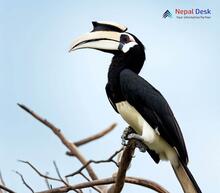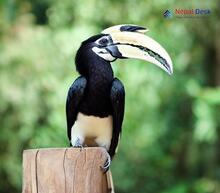Nestled between the towering peaks and lush valleys of Nepal, you'll find an extraordinary array of wildlife. Among this diverse ecosystem, Bucerotinae birds, a captivating subfamily of hornbills, make their homes in this breathtaking region. The vivid colors and distinct features of these birds have captivated nature enthusiasts, researchers, and tourists alike. Let's delve into the fascinating world of Bucerotinae birds found in Nepal and discover what makes them such a remarkable group.
Bucerotinae: An Introduction to Hornbills
Hornbills belong to the Bucerotidae family and are widely recognized by their unique beaks shaped like a casque. Their striking features set them apart from other avian species. Bucerotinae is a subfamily of hornbills that consists primarily of Asian species, but its members can also be found in Africa. In Nepal, the Great Hornbill and Oriental Pied Hornbill are two prevalent examples you may encounter while exploring the country's natural wonders.
The Great Hornbill: Majesty Amongst the Treetops
The aptly-named Great Hornbill (Buceros bicornis) is an awe-inspiring sight due to its impressive size and bright yellow and black casque. These majestic birds prefer mature forests with tall trees that provide ample nesting opportunities. As primary cavity nesters, female hornbills seal themselves inside tree hollows along with their eggs, creating a small hole for their mates to deliver food.
Great hornbills are known for their fidelity to their partners; they mate for life and participate in cooperative breeding. Moreover, they play a critical role in seed dispersal as they consume large amounts of fruits from various tree species, contributing to forest regeneration.
Oriental Pied Hornbill: Agile and Adaptable
The Oriental Pied Hornbill (Anthracoceros albirostris), with its striking black and white plumage, is an agile and adaptable member of the Bucerotinae subfamily found in Nepal. They can adjust to various habitats, including cultivated areas and degraded forests, but prefer deciduous and evergreen woodlands.
Though smaller in size compared to their Great Hornbill cousins, Oriental Pied Hornbills also engage in cooperative breeding. Furthermore, they boast a varied diet consisting of fruits, insects, amphibians, and even small mammals.
Conservation: Protecting Nepal's Bucerotinae Birds
In recent years, the Bucerotinae bird population has faced threats such as habitat loss and hunting. Conservation efforts to protect these fascinating creatures include habitat restoration, nest protection initiatives, and educating local communities about the significance of these birds for their ecosystem.
As we continue to learn more about Nepal's Bucerotinae birds through research and conservation efforts, we discover the profound connection between this captivating avian subfamily and their natural world. By recognizing their importance and taking steps to preserve their habitats, we enable future generations to experience the wonder that these winged inhabitants bring to the land of snow-capped peaks and verdant valleys.





